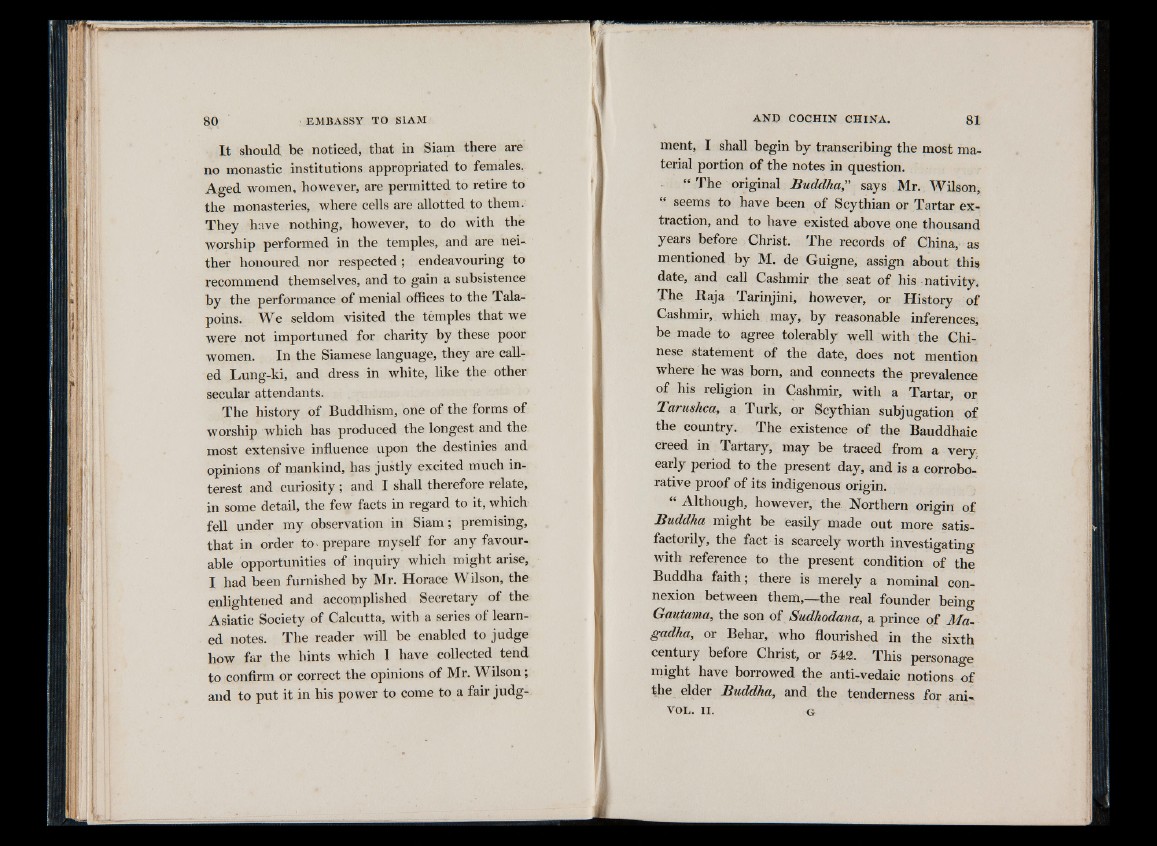
I t should be noticed, that in Siam there are
no monastic institutions appropriated to females.
Aged women, however, are permitted to retire to
the monasteries, where cells are allotted to them.
They have nothing, however, to do with the
worship performed in the temples, and are neither
honoured nor respected; endeavouring to
recommend themselves, and to gain a subsistence
by the performance of menial offices to the Tala-
poins. We seldom visited the temples that we
were not importuned for charity by these poor
women. In the Siamese language, they are called
Lung-ki, and dress in white, like the other
secular attendants.
The history of Buddhism, one of the forms of
worship which has produced the longest and the
most extensive influence upon the destinies and
opinions of mankind, has justly excited much interest
and curiosity ; and I shall therefore relate,
in some detail, the few facts in regard to it, which'
fell under my observation in Siam ; premising,
that in order to-prepare myself for any favourable
opportunities of inquiry which might arise,
I had been furnished by Mr. Horace Wilson, the
enlightened and accomplished Secretary of the
Asiatic Society of Calcutta, with a series of learned
notes. The reader will be enabled to judge
how far the hints which 1 have collected tend
to confirm or correct the opinions of Mr. Wilson ;
and to put it in his power to come to a fair judgment,
I shall begin by transcribing the most material
portion of the notes in question.
“ The original Buddha,” says Mr. Wilson,
seems to have been of Scythian or Tartar extraction,
and to have existed above one thousand
years before Christ. The records of China, as
mentioned by M. de Guigne, assign about this
date, and call Cashmir the seat of his nativity.
The Baja Tarinjini, however, or History of
Cashmir, which may, by reasonable inferences,
be made to agree tolerably well with the Chi-
nose statement of the date, does not mention
where he was born, and connects the prevalence
of his religion in Cashmir, with a Tartar, or
Tarushca, a Turk, or Scythian subjugation of
the country. The existence of the Bauddhaic
creed in Tartary, may be traced from a very
early period to the present day, and is a corroborative
proof of its indigenous origin.
“ Although, however, the. Northern origin of
Buddha might be easily made out more satisfactorily,
the fact is scarcely worth investigating
with reference to the present condition of the
Buddha faith; there is merely a nominal connexion
between them,—the real founder being
Gautama, the son of Sudhodana, a prince of Ma-
gadha, or Behar, who flourished in the sixth
century before Christ, or 542. This personage
might have borrowed the anti-vedaic notions of
the elder Buddha, and the tenderness for ani-
VOL. I I . G